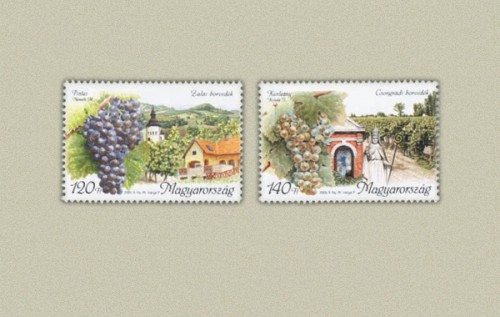
1. MAGYAR - MAGYAR BORVIDÉKEK VII. - Bélyeg rendelési kód: 2005 év bélyegei kompletten
2. ENGLISH - HUNGARIAN WINE REGIONS VII. - Order code of the stamp: 2005 Year stamps complete
3. GERMAN - Ungarischen Weinregionen VII. - Marke die sprechstunde kode: 2005 Jahr Briefmarken komplett
1. MAGYAR - MAGYAR BORVIDÉKEK VII.
A Magyar Posta Rt. folytatja hazánk borvidékeit bemutató bélyegsorozatának kibocsátását. A két címletből álló sor bélyegképein a Zalai és a Csongrádi borvidék került megörökítésre.
A Zalai borvidék területe 12.000 hektár, és három részre oszlik: a Csáfordi, a Szentgyörgy-vári és a Mura-vidéki körzetekre.. Éghajlati viszonyai miatt (600-800 mm évi csapadék) csak a kimondottan kedvező fekvésekben folyik minőségi bortermelés. Magyarországi okiratok szerint már a filoxéra elterjedése előtt is kedvelt borok teremtek a zalai borvidéken.
A Pintes szőlőfajtát Dr. Németh Márton szelekciós munkája során a Pécs-Cserkúti szőlőkben találta. Származását tekintve ősi magyar eredetű szőlőfajtának tekintette, amit már a filoxéravész előtt is termesztettek a Kárpát medencében.
A Pintes szőlőfajta termesztését – 1977. évi állami elismerése után – főleg a Dunántúli borvidékre javasolták. Zala megyében Csáford környékén talált igazi otthonra. A Pintes borát kedvező illat és aromagazdagság jellemzi. Ízvilága sajátos színfoltot képvisel az európai borok palettáján.
Csongrádi borvidék 5.700 hektáron található az Alföldön, ahol az ország szőlőterületének 60%-a található. A Kárpát medence mély fekvésű területein a fagyveszély miatt az ún. kétszintű művelési forma alakult ki, ami azt jelentik, hogy a köztes gyümölcsös és erdőtelepítés védelmet nyújtott a gyakori fagykárok ellen. Az alföldi szőlőkultúra fenntartása különös hangsúlyt kapott a filoxéravész megjelenésével, mert az immunis homoktalajban nem élt meg a filoxéra.
Kezdetben a karó nélküli gyalogművelés volt a meghatározó, majd a kultúrigények növekedésével és az új művelési módok elterjedésével kimondottan fagytűrő és betegségeknek ellenálló szőlőfajtákra volt szükség. A Kunleány, mint hungaricum kiváló fagytűrő-képességével biztosítja az ott élő emberek megélhetését. A fajtát a Kertészeti Egyetem Szőlőnemesítési Tanszékén Dr. Koleda István állította elő.
Állami elismerést 1975-ben kapott. A Kunleány szőlőfajta nagy értéke az ellenálló-képessége és környezetbarát termeszthetősége. Borának finom illata és zamata miatt minőségi kategóriába sorolható.
A bélyegsorhoz tartozó alkalmi borítékot - Magyarország körvonalain belül - a szőlőtermő vidéket ábrázoló fotóalapú grafika díszíti. Az alkalmi bélyegző, a boríték rajzzal összhangban, hasonló motívumokból áll.
Megjelenési időpont: 2005. május 25.
Forrás: Philatelia Hungarica Kft., Magyar Posta
2. ENGLISH - HUNGARIAN WINE REGIONS VII.
The Hungarian Post Office Ltd. is continuing its series of stamps presenting Hungary’s wine regions by is-suing a two-denomination set of stamps featuring the Zala and Csongrád wine regions.
The Zala wine region covers an area of 12,000 hectares and has three districts, Csáford, Szentgyörgy-vár and Muravidék. Due to its climatic conditions (with an annual rainfall of 600-800 mm) quality wine is only produced in very well positioned vineyards. Documentary evidence shows that the Zala wine region pro-duced popular wines well before phylloxera spread in the 19th century.
The grape variety Pintes was discovered by Dr Márton Németh during his selection work in the Pécs-Cserkút vineyards. He believed it was an old Hungarian variety cultivated in the Carpathian Basin before phylloxera struck. After it was recognised by the state in 1977, production of the variety was mainly recom-mended in Transdanubia, and it found its most suitable location around Csáford in Zala county. Pintes pro-duces wine with a good bouquet rich in aromas and a distinctive taste, unique among European wines.
5,700 hectares are under vine in the Csongrád wine region on the Great Hungarian Plain, where 60% of the country’s wine-growing area lies. In low-lying sections of the Carpathian Basin a so-called two-level cultiva-tion method, interspersing vineyards with orchards and woods to offer greater protection against frequent frost damage, was employed. Viniculture on the Great Plain gained special significance with the appear-ance of the phylloxera as the pest cannot live in its sandy soil.
At first vines were generally cultivated without supports, then demands for higher standards grew and new cultivation methods for frost- and disease-resistant varieties were increasingly needed. Kunleány, a Hunga-ricum, with its excellent frost-resistance ensures the local people’s livelihood. The variety was produced by Dr István Koleda at the University of Horticulture’s Vine Breeding Faculty. It gained state recognition in 1975. The variety’s great value is its resistance and ability to produce in environmentally friendly conditions. The variety produces quality wines with a fine bouquet and flavour.
The first day cover for the set of stamps bears a graphic design based on a photograph depicting a vine-growing area within the outline of Hungary. The special postmark has motifs in keeping with the commemo-rative cover.
Date of issue: 25 May 2005
3. GERMAN - Ungarischen Weinregionen VII.
Die Ungarische Post bélyegsorozatának zeigt Weinregionen unseres Landes werden weiterhin ausgestellt werden. Die beiden Konfessionen der Zala und Ort des Bildes Csongrád Weinregion wurde Verewigung.
Zala Fläche von 12.000 Hektar Weinbau-Region und in drei Teile: die Csáfordi die Szentgyörgy-VARIO-Mura und ländlichen Gebieten verteilt .. Angesichts der klimatischen Bedingungen (600-800 mm Jahresniederschlag), nur die speziell gute Qualität Wein fekvésekben. Ungarn, nach Dokumente, die bereits vor beliebt, auch die Ausbreitung der Reblaus Weine der Region Zala machen.
Die Pintes Rebsorte Auswahl Arbeit von Dr. Martin Nemeth Pécs-Cserkúton Weinbergen gefunden. Der Ursprung der alten ungarischen Herkunft, Rebsorte, die Auffassung, dass der Schädling hat auch vor im Karpatenbecken hergestellt wurden.
Die Pintes Weinbau - 1977. Nach Jahren der öffentliche Anerkennung - vor allem in Transdanubien vorgeschlagen Weinregion. Komitat Zala in der Nähe gefunden Csáford ein richtiges Zuhause. Die positive Pintes Weinaroma und aromagazdagság gekennzeichnet. Patch stellt eine besondere Vorliebe für europäische Weine Palette.
Csongrád Weinbaugebiet in 5700 Hektar des Great Plains, wo 60% der Fläche des Landes Rebflächen eingezeichnet ist. Die Karpaten-Becken im Flachland der sogenannten Frostgefahr. entwickelt ein Zwei-Klassen-Form des Anbaus, was bedeutet, dass die vorläufigen Rechtsschutz gewährt, um die Obst-und Waldlandschaft mit häufigen gegen Frostschäden. Das Tiefland Weinberge mit besonderem Schwerpunkt auf die Erhaltung der Auftritt der Reblaus, denn der Sand hat sie nicht immun gegen die Reblaus gemacht.
Ursprünglich war der Pole ohne gyalogművelés die dominante, dann ist die kultúrigények Wachstum und Verbreitung der neuen landwirtschaftlichen Methoden, die speziell Frost und Krankheiten resistent Reben war nicht erforderlich. Die Kunleány als Hungaricum Fähigkeit, hohe bieten-frost-indigenen Menschen Lebensunterhalt. Die Rebsorte ist der Gartenbau-Abteilung der Universität, Dr. Stephen KOLEDA hergestellt.
Die staatliche Anerkennung im Jahre 1975 erhielt. Die Kunleány Vielzahl von hochwertigen und umweltfreundlichen Widerstand termeszthetősége. Wein aus zarten Aroma und Geschmack wegen der Qualität Kategorien.
Bélyegsorhoz der gelegentlichen Umschlag - Vereinigte Arabische Emirate, im Überblick - der Weinbau-Region sind mit Werken darstellen fotóalapú eingerichtet. Die gelegentliche Stempel, den Umschlag mit einer Zeichnung, mit ähnlichen Motiven.










